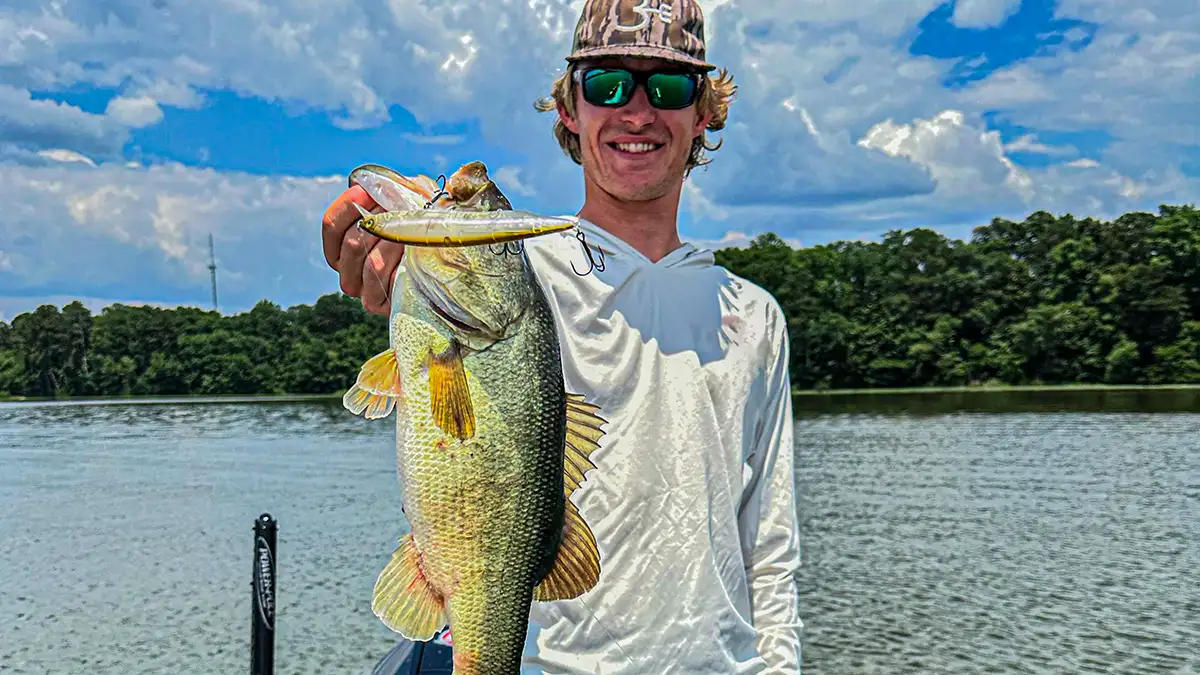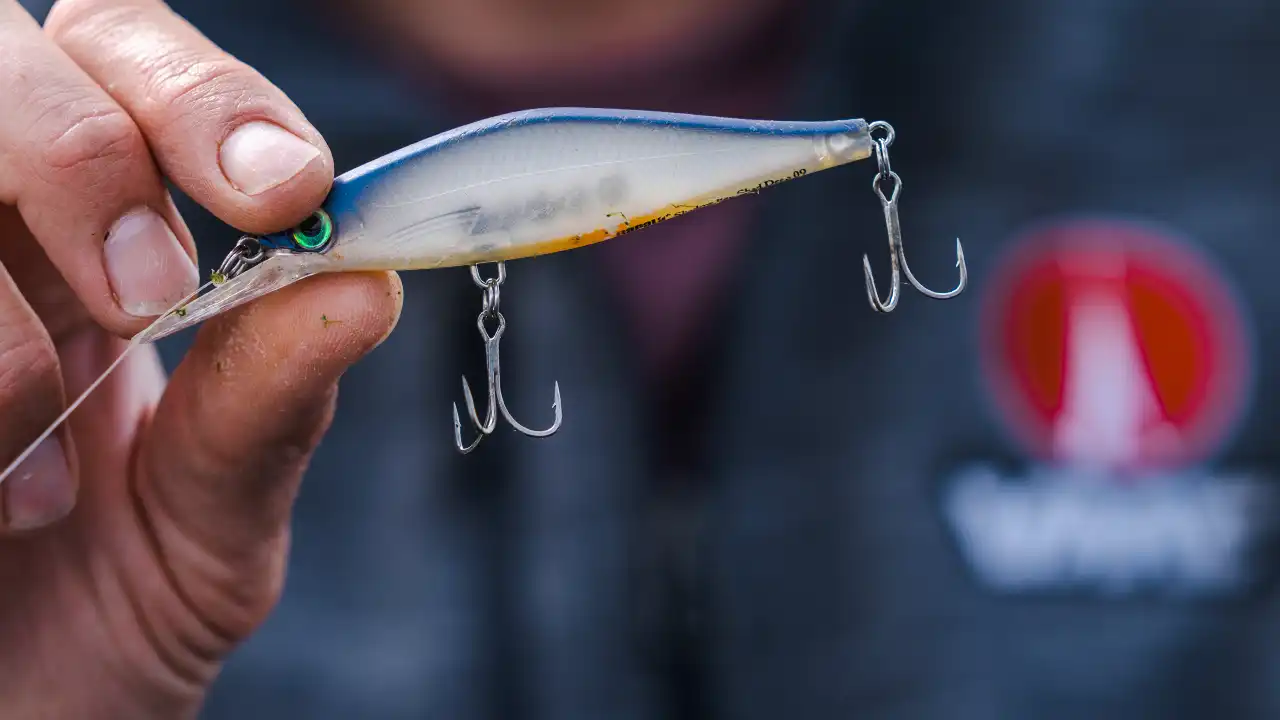Brush piles have been a popular spot to catch bass since the sport of bass fishing began. These high percentage locations exist on nearly every lake in the country, providing bass with the perfect cover to to hide and ambush bait. Both baitfish and bass alike use these isolated brush piles for cover, which makes them the perfect location to fish a jerkbait.
Different brush piles are good depending on the time of year. This is why it is important to understand what makes a brush pile productive depending on the season and current weather conditions. There are three main things that are important to look for when targeting brush piles with a jerkbait in the summer. These three factors include Isolated cover, depth and low-light conditions.

ISOLATED STRUCTURE
It is a known fact that some of the biggest fish on the lake like to hold on isolated cover. Whether it be a lone dock, piece of standing timber, or an isolated brush pile, these pieces of cover are always a high percentage location to get a really big bite. Furthermore, these pieces of cover cause fish to group up in a specific locations.
Brush piles often cause the majority of fish in the area to hold on that specific cover. This makes it much easier to locate fish when searching through a large body of water. When fishing an area full of cover, it will often take you numerous casts to locate a specific spot where the fish are holding. This is why it is important to located these high percentage isolated brush piles.
These types of locations allow you to keep your bait in front of fish for longer periods of time without searching through dead water. By making repeated casts at the same piece of cover, you are often able to coax the bass into biting by giving them different angles and varying your lures cadence.
DEPTH IS EVERYTHING
Another important factor when locating productive summertime brush piles is depth. One of the most productive ways to pattern a brush pile bite is by targeting cover in similar depths. Once you locate a productive brush pile, start looking at other piles in a similar depth range to see if they are also holding fish. This is a quick way to get on a very productive brush pile bite.
During the summer months, bass typically hold on deeper cover. This is why I like to focus on brush piles in the 10 to 25-foot range. As water temperatures increase, the upper water column becomes nearly uninhabitable for the majority of fish. Here in Alabama, we are seeing water temps in the mid 90s. This pushes the majority of fish down into the deeper, more comfortable water.
When searching for these deeper brush piles, side scan is a great way to quickly locate these high percentage locations. I like to start by setting my side scan at 100-120-feet in order to see these brush piles at an increased distance. When searching for fish, I typically keep my side scan around 65 feet, allowing me to see them much easier. However, when looking for big pieces of cover such as brush piles you are able to increase your range due to their larger size. Ive also found brush piles that stick straight up off the bottom are more conducive to catching fish on a jerkbait. This vertical structure allows bass to suspend up off the bottom, making them more willing to chase down your jerkbait as you work it past the cover.
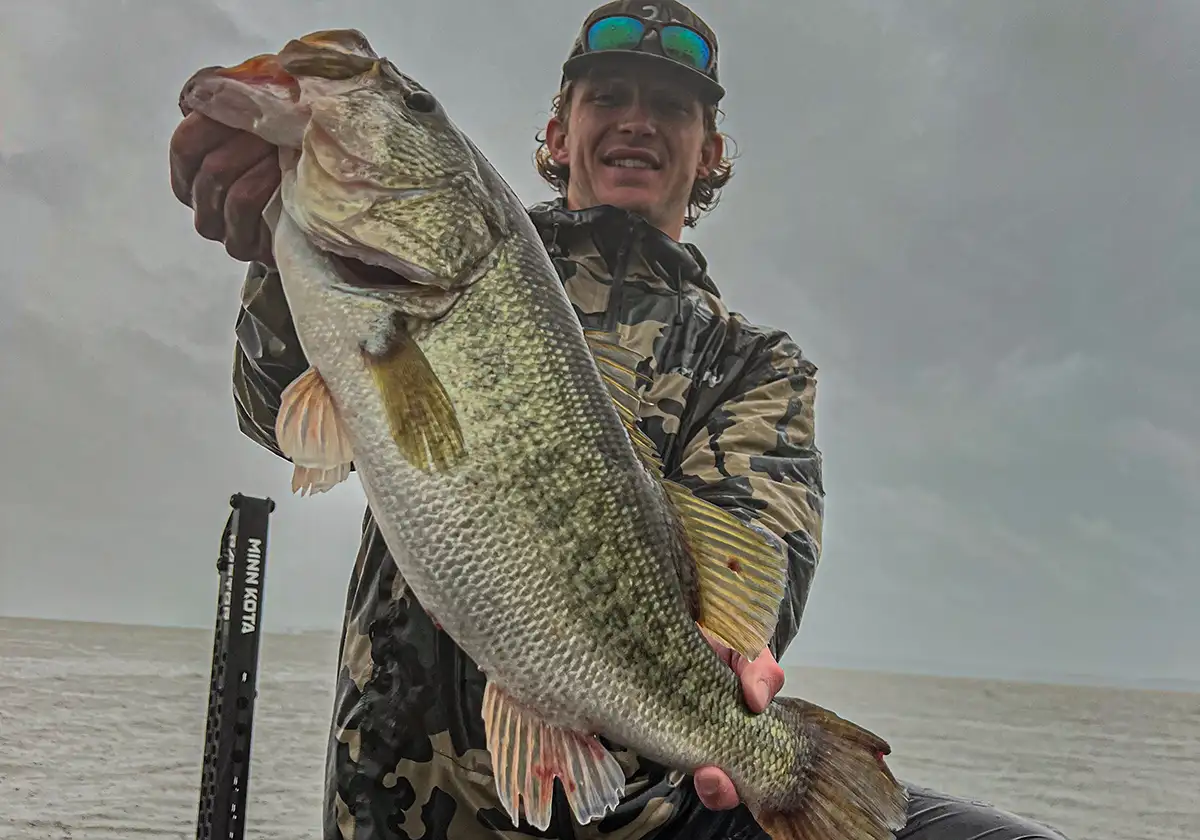
CONDITIONS MATTER
Weather conditions are a super important factor when trying to locate a productive jerkbait bite. While you can catch fish on a jerkbait 365 days out of the year, there are certain conditions that can lead to a much more productive day of jerkbait fishing.
Heavy sun often causes fish to hold tight to the bottom or a piece of cover. They are often less willing to travel long distances to chase down a bait, and prefer a more subtle slow moving presentation. However, you are still able to throw a jerkbait during these types of days, especially with the presence wind. Wind helps break up the surface of the water keeping fish from getting a good look at what’s above them. This makes fish far more willing to chase down a bait and commit, even when the sun is high.
Another important weather factor to look for is low light conditions. Heavy clouds greatly decreases a bass’s vision and makes it much more wiling to suspend up off the bottom and chase bait. When the weather is sunny, fish will hold right next to the brush pile waiting for bait to come to them and present an easy meal. However, when it is cloudy bass will often roam in the general vicinity of the brush pile. This is the perfect time to pick up a jerkbait and target these fish using your live sonar.
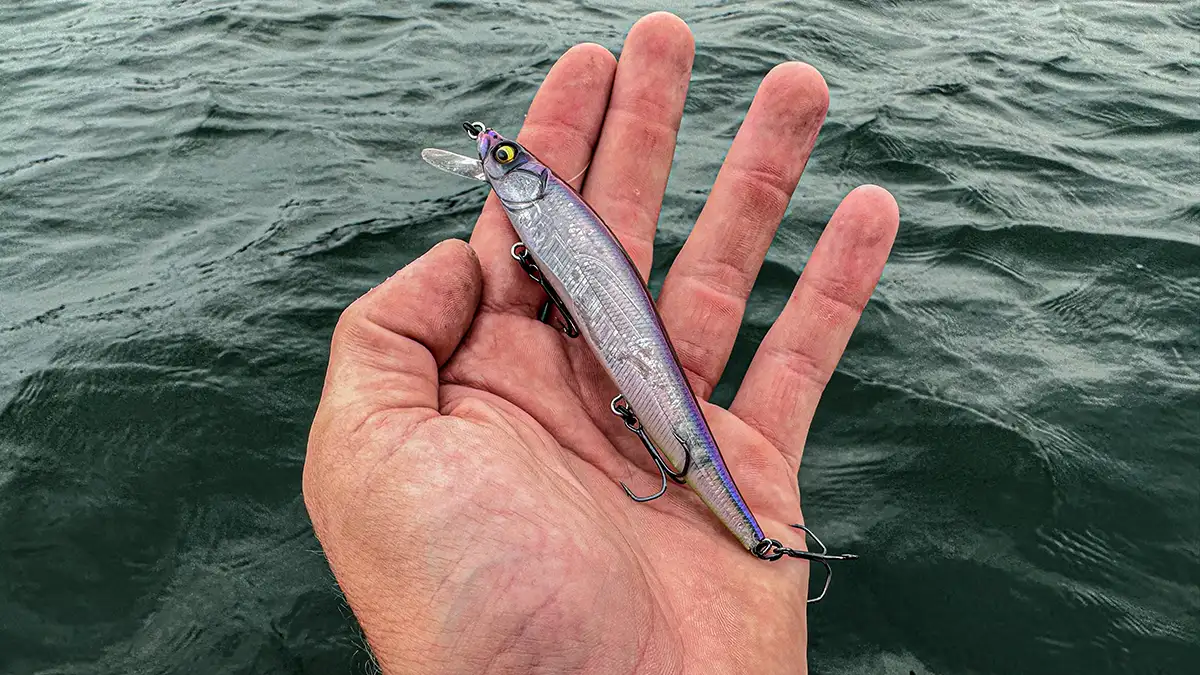
FISHING A JERKBAIT USING LIVE SONAR
The art of jerkbait fishing has changed dramatically since the invention of live sonar. This technology allows you to target specific fish as well as see how they react to your baits presentation. This technology has taught us a few key techniques that can help you get more bites.
When approaching a brush pile, it is important to stay a good distance away allowing the fish enough room to chase down your bait without getting too close to the boat. I typically stay anywhere between 60 to 80-feet away. This allows the fish enough space to notice your bait then follow it for an extended period of time without getting spooked by the boat.
You should then cast your jerkbait over the brush pile or specific fish, and work it back to the boat implementing erratic jerks and pauses. Fish like to feed upwards, so it is important to always try and keep your bait above the fish’s head. You can then watch how he fish reacts to your bait as you bring it back to the boat. I will often vary the speed of my retrieve based on how the fish are acting.
One important thing to pay attention to when watching fish react on live sonar is the speed in which they approach your bait. If a fish rockets out of a brush pile towards your lure, it will typically commit. However, if a fish is slowly approaching your bait, they often will just follow it to the boat. I like to speed up my retrieve when fish are slowly approaching my bait, giving them the allusion of a fleeing baitfish. Fish also tend to move much quicker during the summer months as apposed to the winter months. This is another reason why I like to speed up my retrieve in order to trigger these fish into biting. A bass can alway swim faster than your bait no matter how quickly you work it, so don’t be afraid to speed up your retrieve to get them to react.
Another great way to get these fish to commit is by looking for groups of fish. Competition from other bass is a great way to get them to fully commit and inhale your jerkbait. The presence of other predatory fish and the competition for food will often cause bass to become much more aggressive and willing to eat your bait. A great way to get these fish to react is to quickly work a jerkbait over their head causing them all to come up at once and compete for the bait.
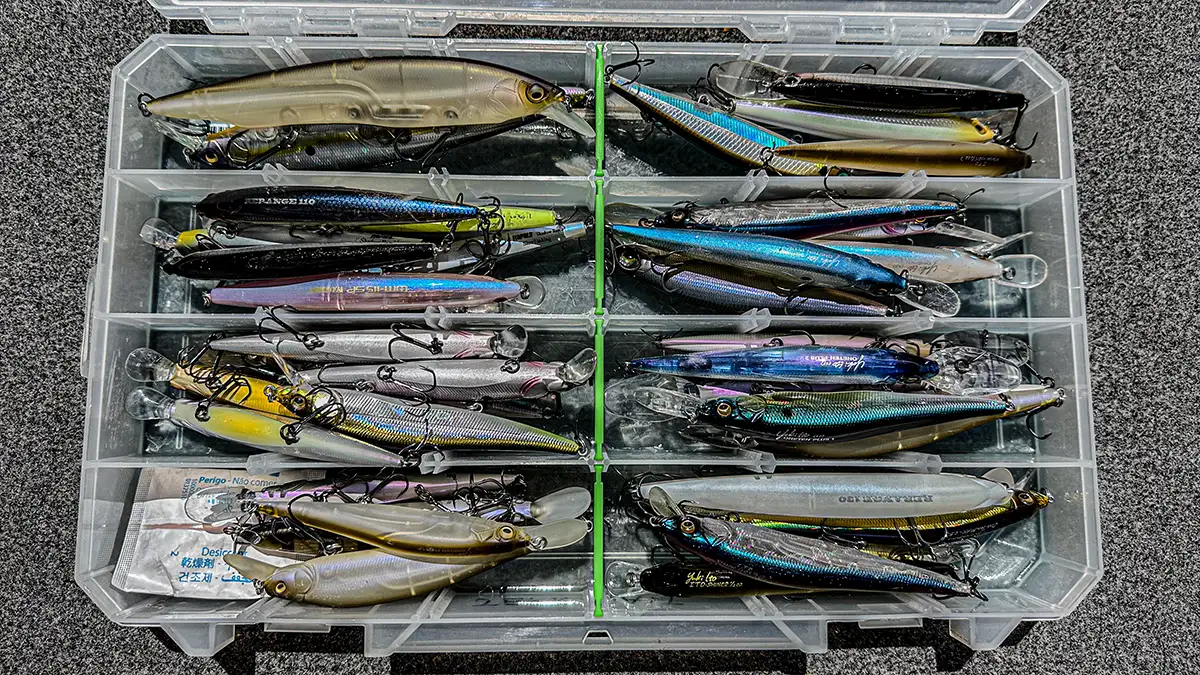
JERKBAIT SELECTION AND MODIFICATIONS
Choosing the right jerkbait is essential for effectively fishing a variety of different depths. You can fish a jerkbait at basically any depth by implementing a variety of different lure modification. My go to jerk baits depending on depth are the Berkley Stunna (full review) and the Megabass Vision 110+1.
I like to use the Berkley Stunna for shallow water brush piles, especially when fishing around larger sized fish. The Berkley Stunna comes stock with Fusion 19 trebles hooks which are great for not bending out during a strenuous fight. This bait also suspends perfectly allowing you to pause it right above the brush pile in order to coax them into eating. This is my go to jerkbait for the majority of shallow water applications.
Berkley Stunna is available at:
When fishing deeper water, I tend to opt for the Megabass Vision 110+1. This bait has a larger bill allowing it to dive to deeper depths while still maintaining its erratic action. This bait also suspends perfectly and can reach depths of 8-12-feet depending on your line size. When fishing these deeper diving jerk baits, I will often add bigger hooks allowing the bait to slowly sink. The larger hooks add more weight to the bait causing it to turn from a suspending jerkbait into a slow sink. This also helps with keeping fish from straightening out your hooks when fighting a larger sized bass.
Megabass Vision 110+1 is available at:
You can also add weight by using Suspend Strips or by wrapping lead wire around your treble hooks. I like to put my Suspend Strips down the middle portion of the bait which allows it to run true without affecting the baits action. When using lead wire, I will wrap the desired amount of wire around each treble hook. This ensures that I distributed the weight equally in order to maintain the baits desired action. This is a great way to get your jerkbait down to your desired depth while still maintaining its erratic action.
JERKBAIT SETUP
When fishing a jerkbait, I prefer a shorter medium action rod with a high speed reel.
This shorter rod allows you to make accurate casts as well as work the bait easily without being too cumbersome. The lighter actions keeps you from ripping the hooks out of the fish’s mouth and allows you to properly fight them all the way back to the boat. My go to rod for this setup is a Dobyns Champion XP 7-foot Medium Action.
For a reel, I prefer one with a faster gear ratio that allows me to pick up line quickly in between jerks. This is great for keeping up with your line while working a jerkbait at a fast speed. My go to reel for this application is the Shimano Curado MGL 150 in the 8:1 gear ratio.
For line, I typically stick with anything between 8 and 12-pound fluorocarbon depending on my desired depth and the amount of cover present. When fishing deep in the water column, lighter line helps you sink you bait down without pulling it back up due to the larger diameter. However when fishing shallow in the water column or around heavy cover I will typically use 12-pound test in order to keep my bait right under the surface and fish out of the cover.
Throwing a jerkbait around brush piles is a great way to catch a ton of bass as they enter into their summer haunts. By implementing these tactics, you will be able to successfully target fish at any depth range you desire. This style of fishing works on nearly every lake in the country, and is a great way for you to go out and catch fish on your favorite body of water.





